.01
St. John's Co-Cathedral
St. John’s Co-Cathedral is unparalleled in its historic significance to Malta. Apart from its place among the most magnificent baroque churches in the world, St. John’s Co-Cathedral is also an architectural metaphor for the Order of the Knights of St. John, who built it between 1573 and 1578. The simple façade reflects the Knights’ military pragmatism, while the gilded vaults, painted ceilings, marble floors and general baroque exuberance of its lavish interior, reveal the sophistication, power and wealth of the Order. It was raised to a status equal to that of St Paul’s Cathedral in Mdina, the official seat of the Archbishop of Malta, by a papal decree of 1816, hence the term ‘co-cathedral’.
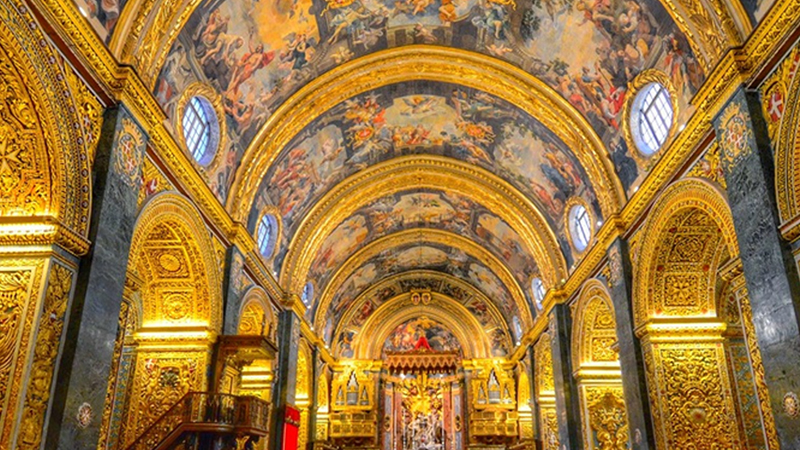
.01
St. John's Co-Cathedral
St. John’s Co-Cathedral is unparalleled in its historic significance to Malta. Apart from its place among the most magnificent baroque churches in the world, St. John’s Co-Cathedral is also an architectural metaphor for the Order of the Knights of St. John, who built it between 1573 and 1578. The simple façade reflects the Knights’ military pragmatism, while the gilded vaults, painted ceilings, marble floors and general baroque exuberance of its lavish interior, reveal the sophistication, power and wealth of the Order. It was raised to a status equal to that of St Paul’s Cathedral in Mdina, the official seat of the Archbishop of Malta, by a papal decree of 1816, hence the term ‘co-cathedral’.
.02
Valletta Entrance
A total of five city gates have served as the main entrance to Valletta. The original gate, known as Porta San Giorgio, was just a rock-hewn passage. It was replaced in 1632 by a more ornate gate, consisting of a central archway with a smaller arch at each side and a wooden drawbridge across the deep, dry moat that lies immediately outside the walls of Valletta. In 1853, at the height of British rule over Malta, a new gate consisting of two central arches with two smaller ones. The present entrance to Valletta is not a gate at all but a striking slice out of the surrounding bastion walls once you have entered over a bridge high above the moat.
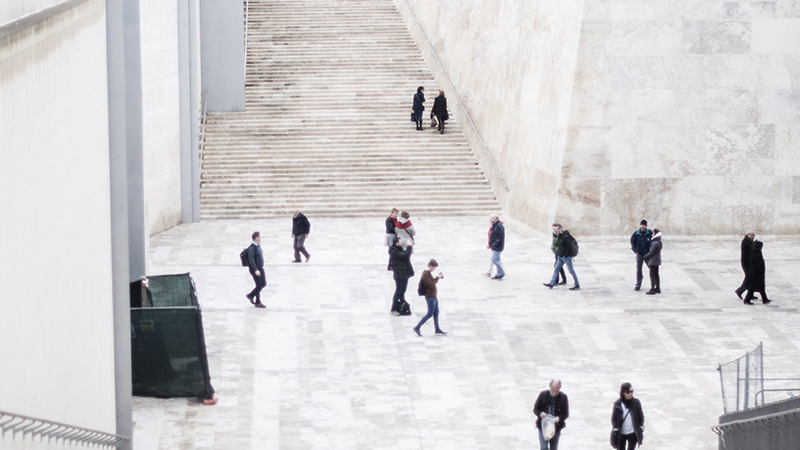
.02
Valletta Entrance
A total of five city gates have served as the main entrance to Valletta. The original gate, known as Porta San Giorgio, was just a rock-hewn passage. It was replaced in 1632 by a more ornate gate, consisting of a central archway with a smaller arch at each side and a wooden drawbridge across the deep, dry moat that lies immediately outside the walls of Valletta. In 1853, at the height of British rule over Malta, a new gate consisting of two central arches with two smaller ones. The present entrance to Valletta is not a gate at all but a striking slice out of the surrounding bastion walls once you have entered over a bridge high above the moat.
.03
Upper Barrakka Gardens
The striking Upper Barrakka Gardens are situated in the capital of Malta, next to the architectural gem of the Castille Palace. The gardens offer jaw dropping and unparalleled views of Grand Harbour, the three cities as well as the breakwater protecting the still water of Grand Harbour. Visitors can spend hours here simply admiring the stunning view. The Upper Barrakka Gardens are built on top of a bastion, on the highest point of Valletta and date back to 1661 when it used to be a private garden of the Knights.
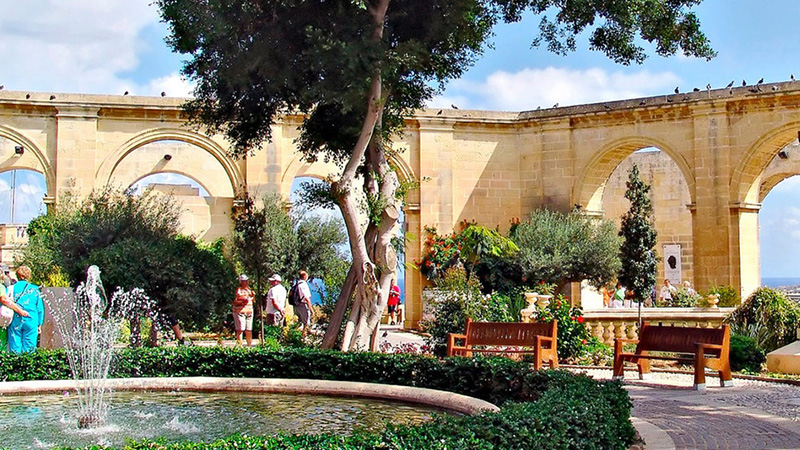
.03
Upper Barrakka Gardens
The striking Upper Barrakka Gardens are situated in the capital of Malta, next to the architectural gem of the Castille Palace. The gardens offer jaw dropping and unparalleled views of Grand Harbour, the three cities as well as the breakwater protecting the still water of Grand Harbour. Visitors can spend hours here simply admiring the stunning view. The Upper Barrakka Gardens are built on top of a bastion, on the highest point of Valletta and date back to 1661 when it used to be a private garden of the Knights.
.04
Auberge de Castille
The Knights of St. John was divided into seven languages or ‘langues’ as administrative divisions of the Knight’s order, each having its own headquarters. The Auberge de Castille is one of the seven original auberges and originally housed the langues of Castile, León and Portugal, which were amongst the most influential within the order. Auberge de Castille is one of the finest architectural works in Malta, as evidenced by its spectacular façade. This finely proportioned was badly damaged during World War II but was later carefully restored and has recently had its façade restored to its original glory. The building now houses the office of the Prime Minister.
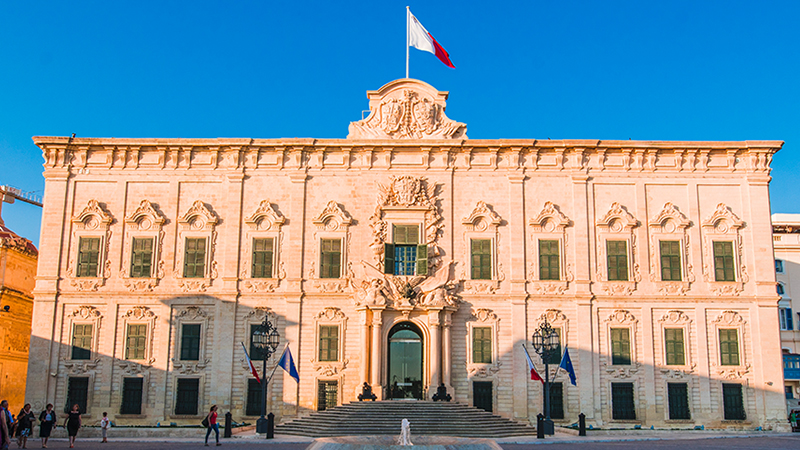
.04
Auberge de Castille
The Knights of St. John was divided into seven languages or ‘langues’ as administrative divisions of the Knight’s order, each having its own headquarters. The Auberge de Castille is one of the seven original auberges and originally housed the langues of Castile, León and Portugal, which were amongst the most influential within the order. Auberge de Castille is one of the finest architectural works in Malta, as evidenced by its spectacular façade. This finely proportioned was badly damaged during World War II but was later carefully restored and has recently had its façade restored to its original glory. The building now houses the office of the Prime Minister.
.05
Ruins of the Royal Opera House
The once majestic Malta Royal Opera House that dominated the entrance to Valletta was built in 1866 as an opera house and performing arts venue. Sadly, this architectural treasure was almost completely destroyed on April 7, 1942 by axis bombing and it has since been redesigned using the old ruins by Italian architect Renzo Piano to once again function as a as an open-air theatre and performance venue.
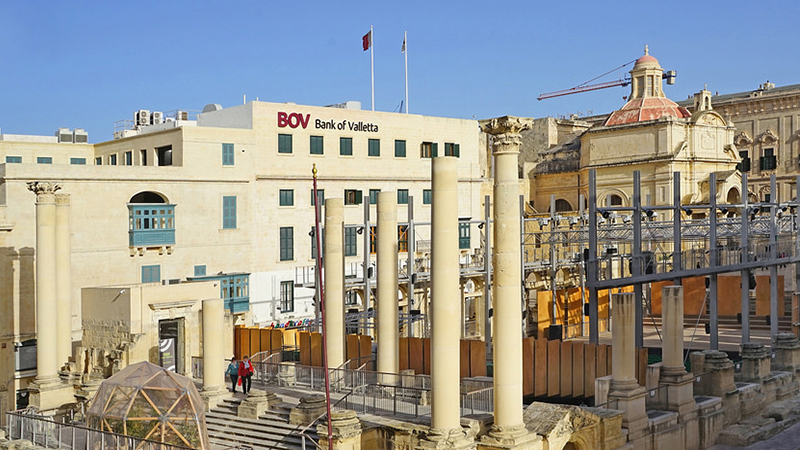
.05
Ruins of the Royal Opera House
The once majestic Malta Royal Opera House that dominated the entrance to Valletta was built in 1866 as an opera house and performing arts venue. Sadly, this architectural treasure was almost completely destroyed on April 7, 1942 by axis bombing and it has since been redesigned using the old ruins by Italian architect Renzo Piano to once again function as a as an open-air theatre and performance venue.
.06
Auberge d'Italie
The Auberge d’Italie, the residence of the Italian Knights, was among the first to be built in Valletta. The building was completed in 1571 in accordance with the project by Gerolamo Cassar but the current facade, with its splendid baroque portal on Merchant Street, was constructed around 1680. It is very likely that Caravaggio spent a lot of time in the Auberge d’Italie during his stay in Malta, probably to meet other Knights who wanted to commission paintings from him but also as his home after he was made a Knight. The Malta Tourism Authority moved office there in 2002 where it remains to this day.
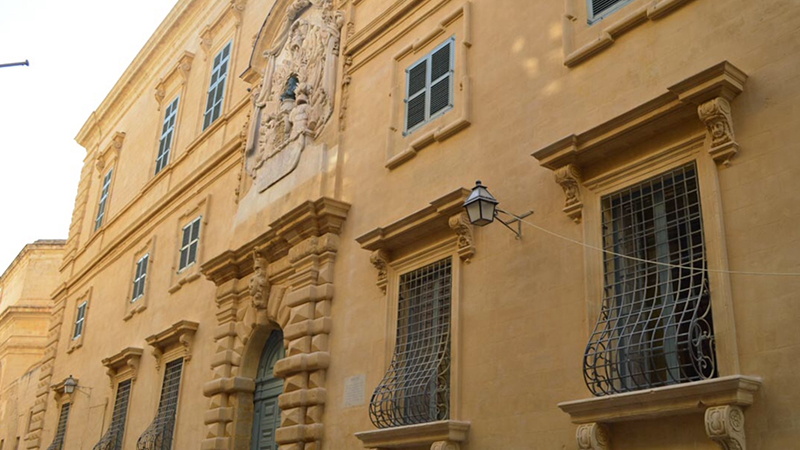
.06
Auberge d'Italie
The Auberge d’Italie, the residence of the Italian Knights, was among the first to be built in Valletta. The building was completed in 1571 in accordance with the project by Gerolamo Cassar but the current facade, with its splendid baroque portal on Merchant Street, was constructed around 1680. It is very likely that Caravaggio spent a lot of time in the Auberge d’Italie during his stay in Malta, probably to meet other Knights who wanted to commission paintings from him but also as his home after he was made a Knight. The Malta Tourism Authority moved office there in 2002 where it remains to this day.
.07
Grand Master's Palace
Dominating Palace Square, the Grandmaster’s Palace was one of the first buildings to be built in Valletta in 1571. The original Palazzo was designed by Gelormu Cassar but successive grandmasters enlarged and developed the building as they deemed fit to use it as their official residence.
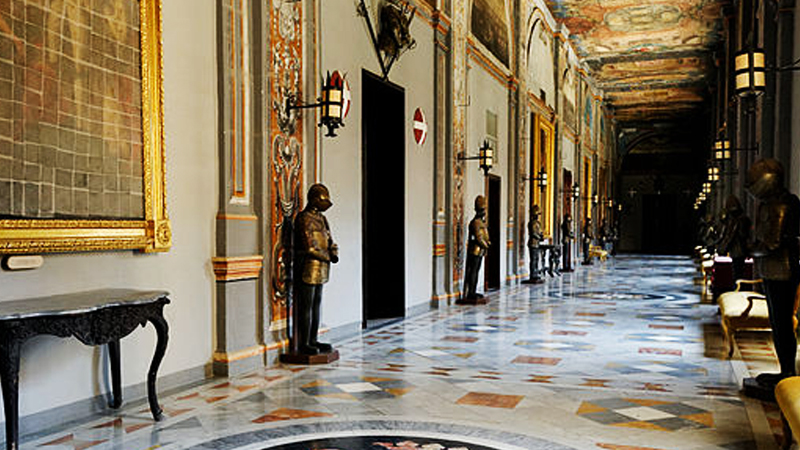
.07
Grand Master's Palace
Dominating Palace Square, the Grandmaster’s Palace was one of the first buildings to be built in Valletta in 1571. The original Palazzo was designed by Gelormu Cassar but successive grandmasters enlarged and developed the building as they deemed fit to use it as their official residence.
.08
The Streets of Valletta
Valletta was one of the first planned cities in the world, having a unique grid system design, but that doesn’t mean that it doesn’t hold many intrigues. Negotiating the labyrinth of narrow historic streets and lanes, ditches and fortifications offers a feeling of adventure as at every turn the visitor expects to stumble on a new discovery. Valletta’s street plan is unique and planned with its defence in mind. Based on a more or less uniform grid, some of the streets fall steeply as you get closer to the tip of the peninsula. The stairs in some of the streets do not conform to normal dimensions since they were constructed in a way so as to allow knights in heavy armour to be able to climb the steps. If you start walking in any of the streets they all lead to the water since the city is a peninsula.
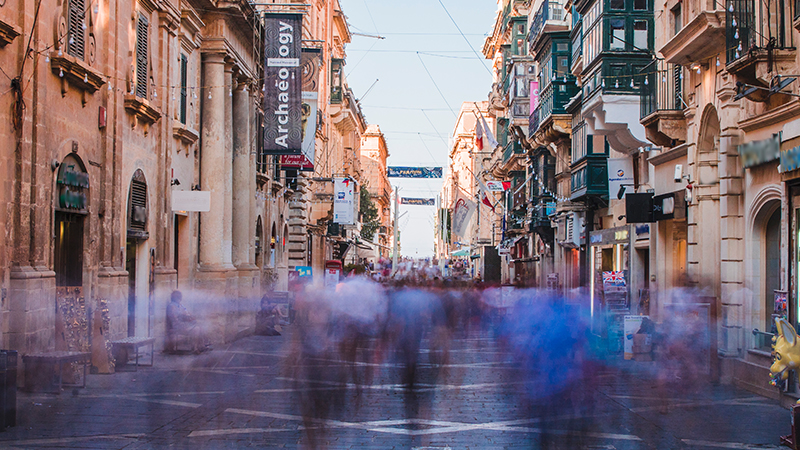
.08
The Streets of Valletta
Valletta was one of the first planned cities in the world, having a unique grid system design, but that doesn’t mean that it doesn’t hold many intrigues. Negotiating the labyrinth of narrow historic streets and lanes, ditches and fortifications offers a feeling of adventure as at every turn the visitor expects to stumble on a new discovery. Valletta’s street plan is unique and planned with its defence in mind. Based on a more or less uniform grid, some of the streets fall steeply as you get closer to the tip of the peninsula. The stairs in some of the streets do not conform to normal dimensions since they were constructed in a way so as to allow knights in heavy armour to be able to climb the steps. If you start walking in any of the streets they all lead to the water since the city is a peninsula.
.09
The Maltese Law Courts
The Maltese courts used to be located at the Auberge d’Auvergne. It was built in the 16th century to house knights of the Order of St, John from the langue of Auvergne. It became a courthouse in the 19th century and it remained so until it was destroyed by aerial bombardment in 1941. The site is now occupied by the Courts of Justice building, which was constructed in the 1960s hence the different architecture of the former hospital.

.09
The Maltese Law Courts
The Maltese courts used to be located at the Auberge d’Auvergne. It was built in the 16th century to house knights of the Order of St, John from the langue of Auvergne. It became a courthouse in the 19th century and it remained so until it was destroyed by aerial bombardment in 1941. The site is now occupied by the Courts of Justice building, which was constructed in the 1960s hence the different architecture of the former hospital.
.10
The Parliament House
The Parliament House is the meeting place of the Parliament of Malta located in Valletta, Malta. The building was constructed between 2011 and 2015 to designs by Renzo Piano as part of the City Gate Project, which also included building a new City Gate and converting the ruins of the Royal Opera House into an open-air theatre. Construction of the Parliament House generated considerable controversy, mainly due to the modern design of the building and the cost of construction, which amounted to around €90 million.
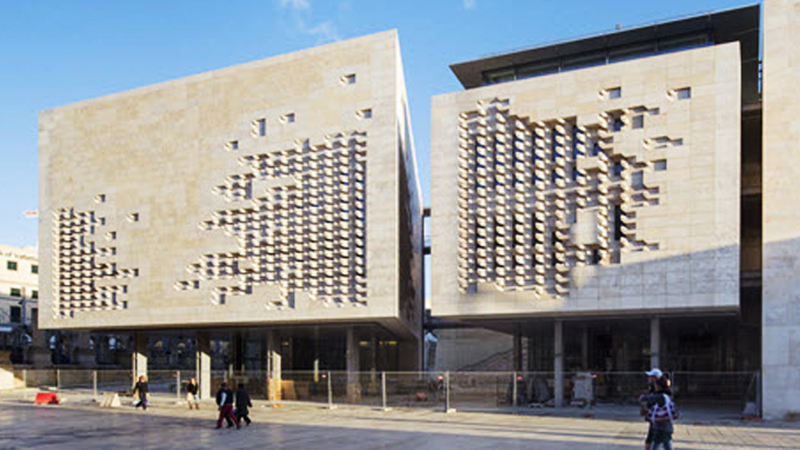
.10
The Parliament House
The Parliament House is the meeting place of the Parliament of Malta located in Valletta, Malta. The building was constructed between 2011 and 2015 to designs by Renzo Piano as part of the City Gate Project, which also included building a new City Gate and converting the ruins of the Royal Opera House into an open-air theatre. Construction of the Parliament House generated considerable controversy, mainly due to the modern design of the building and the cost of construction, which amounted to around €90 million.